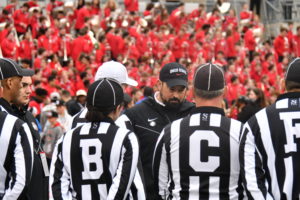NCAA Issues Name, Image And Likeness Guidance To Schools

The NCAA Division I Board of Directors issued new guidance to schools on Monday regarding recruiting and name, image and likeness (NIL).
This guidance, which was developed “by a task force of national leaders with student-athlete opportunity at the forefront of discussions,” defines a booster as any third-party entity that promotes an athletic program or assists with recruiting or providing benefits to recruits, enrolled student-athletes or their family members.
The board specifically notes that this definition could include collectives, which are booster-led groups that were created to help facilitate NIL deals between student-athletes and prospective businesses.
According to a copy of the guidance obtained by Sports Illustrated, boosters may not communicate with a “prospective student athlete” for a recruiting purpose or to encourage their attendance to a specific university. Additionally, coaches and university staff cannot organize or facilitate meetings between recruits and boosters, and they cannot communicate with a recruit on behalf of a booster.
The new guidance also notes that NIL agreements must be based on a “case-by-case” analysis of the value a student-athlete can bring to an NIL agreement, rather than a deal providing compensation for enrollment decisions, athletic performance, achievements or membership on a team. The latter point brings into questions several deals that have been brokered, such as a deal by an NIL collective for Texas that provides each scholarship offensive lineman with $50,000.
The guidance notes that NCAA recruiting rules do not allow for boosters to recruit and/or provide benefits to prospective student-athletes, but several reports have indicated that collectives across the country are working with recruits and already have deals in place with some, include a speculated $8 million deal for a five-star prospect in 2023.
Ohio State has two notable collectives in operation, including The Foundation – launched in February by Ohio State booster Brian Schottenstein and former Buckeye quarterback Cardale Jones as a registered nonprofit – and the Cohesion Foundation, which was founded by former Ohio State walk-on receiver Gary Marcinick and has the support of several Ohio State legends, including Archie Griffin and Jack Nicklaus.
The new guidance is effective immediately, and for violations that occurred prior to May 9, the board is directing the enforcement staff to review the facts of individuals cases for those that, “clearly are contrary to the published interim policy, including the most severe violations of recruiting rules or payment for athletics performance.”
Board chair and University of Georgia president Jere Morehead said the board took a significant first step on Monday to address the “challenges and improper behaviors” that have existed in the NIL space since last year.
“While the NCAA may pursue the most outrageous violations that were clearly contrary to the interim policy adopted last summer, our focus is on the future,” he said. “The new guidance establishes a common set of expectations for the Division I institutions moving forward, and the board expects all Division I institutions to follow our recruiting rules and operate within these reasonable expectations.”
In the release, the board emphasized continued support for student-athletes benefiting from their name, image and likeness, and added that NIL is “rapidly evolving.” Additionally, the board stated that the emphasis of the new guidance is for boosters in the recruiting process, and is not meant to put the eligibility of student-athletes in question with the exception of “the most serious actions that clearly violate the previously published interim policy (and) would have eligibility implications.”